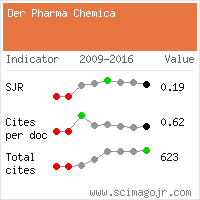Research Article - Der Pharma Chemica ( 2025) Volume 17, Issue 1
Phenotypic Diversity of BmNPV Isolated from Different Geographical Locations of South India: A Biophysical Study
Madhuri Sathyanarayana*, S. E. Neelagund, Dayanand B. Sajjan and Rajat HegdeMadhuri Sathyanarayana, Department of Biochemistry, Kuvempu University, Shankaraghatta, India, Email: myidmadhuri@gmail.com
Received: 30-Sep-2024, Manuscript No. DPC-23-102259; Editor assigned: 03-Oct-2024, Pre QC No. DPC-23-102259 (PQ); Reviewed: 17-Oct-2024, QC No. DPC-23-102259; Revised: 31-Jan-2025, Manuscript No. DPC-23-102259 (R); Published: 28-Feb-2025, DOI: 10.4172/0975-413X.17.1.610-613
Abstract
Viral diseases take the lives of n number of silkworms each year resulting in 30%-40% of average crop loss. Grasserie is one of the deadly diseases caused by NPV (Nuclear Polyhedrosis Virus) for silkworm. BmNPV was observed throughout the year with increased severity in the summer and autumn crops. Morphological parameters of occlusion bodies of BmNPV from different strains were examined to validate in detail structure of these viruses. This examination mainly focused on light microscopic and electron microscopic study along with size and surface charge determination using SZ-100 nanoparticle series instrument. Resulted in intelligible images of different isolates under various magnifications. Further, the average OB size was found to be 150.7 nm, 138.8 nm, 143.8 nm, 140.0 nm and 140.5 nm in diameter for HRH, HSR, KNK, MSI and VKK BmNPV strain respectively. The zeta potential is often measured as a function of pH or other change in the chemistry to help formulators create new products with a long shelf life. The zeta-potentials of isolates were found to be more of negative because of the presence of PEP with the charge of -29.0 mV, -35.4 mV, -45.0 mV, -28.1 mV and -23.5 mV for HRH, HSR, KNK, MSI and VKK BmNPV strain respectively. Thus, by uncovering these aspects may help to spell out indetail phenotypic diversity of BmNPV isolates from South India.
Keywords
BmNPV; Grasserie; Light microscopy; Scanning Electron Microscopy (SEM); Parcticle Size Analysis (PSA); Zeta potential
Introduction
Silk production has been a major cultural significance in India, China and Japan by providing much needed employment, income and foreign exchange. In other developing and labour rich countries, especially India is considered to be the second largest producer and consumer of silk along its allied products. Interest in Baculovirus was due to the threat they posed to the silk industry, though they play a major role in the control of natural insect populations [1].
Silkworms are more sensitive to nutritional factors, outer environmental and microbial attacks, resulting in various deadly diseases leading to silkworm mortality and cocoon crop loss throughout the year. The most and serious diseases in the silkworm are grasserie, muscardine, flacherie and pebrine caused by virus, fungi, bacteria and microsporidia, respectively. A number of viruses, including Nucleopolyhedrovirus (NPV), Infectious Flacherie Virus (IFV), Densovirus (DNV) and Cypovirus (CPV) are known to infect the B. mori. Among the viral diseases, nuclear polyhedrosis is most severe and contagious. It can affect B. mori in different stages of its life cycle that could lead to serious damage and significant financial losses, thus posing a serious threat to the global sericulture. In India, the cocoon crop loss due to diseases was reported as 15%-20%. Viral diseases account for almost 70% of the total loss due to diseases. Due to this, it’s very necessary to understand some morphological and molecular characteristics of BmNPV to prevent grasserie [2].
Baculo viruses are one of the largest viral groups and have been found in over 300 species of insects, mainly Lepidoptera and Hymenoptera. These (Baculoviridae) are a family of rod-shaped ODV (Occlusion derived viruses) with circular, supercoiled, double-stranded DNA genomes ranging in size from 80 to 180 kb. They are pathogens specific to insects, particularly to Lepidoptera, Hymenoptera and Diptera. The genome is packaged in rod-shaped nucleocapsids that are 230 nm-385 nm in length and 40 nm-60 nm in diameter. In the most well characterized baculoviruses, the virions are present as two types, Occluded Virions (ODV) and Budded Virions (BV). Although these two types of virions are similar in their nucleocapsid structure, they differ in the origin and composition of their envelopes and their roles in the virus life cycle [3].
In this study, we observed the phenotypic morphology of baculovirus in nanometer scale by particle size analysis and measured surface charges of virus particles by zeta potential study along with this, Light Microscopic (LM) and Scanning Electron Microscopic (SEM) study has been conducted to know more about structural organization of the virus. Additionally, the alternative methods for isolation of baculovirus were also discussed.
Zeta potential can be assessed through the electrophoretic mobility of particles, which is defined by the ratio of the drift velocity of particles and the applied electric field and it is measured by either micro electrophoresis or Electrophoretic Light Scattering (ELS). Particle size distribution study of viruses revealed the difference in size of baculovirus particle which were collected from different locations. Thus, these findings may help in developing PEP layer-based biopolymers for protein based nano devices, nano electrodes and more stable bio pesticides. The zeta potential is often measured as a function of pH or other change in the chemistry to help formulators create new products with a long shelf life. New approaches, such as genetic engineering, have been employed to increase the pathogenicity of baculovirus pesticides [4].
Materials and Methods
Collection of infected silkworms
Grasserie infected silkworms were collected from different South Indian regions. That are listed in the Table 1 below.
| Sl.No | State | Strains | Place | GPS coordinates in decimal degrees |
|---|---|---|---|---|
| 1 | Karnataka | KNK | Kachinakatte | 13.855071,7559 |
| 2 | Andhra Pradesh | VKK | Karakunta (Venkatagirikota) | 12.953140, 78.467713 |
| 3 | Tamilnadu | HSR | Hosur | 12.721624, 77.813017 |
| 4 | Andhra Pradesh | HRH | Galagala (Anantapur) | 14.611811, 76.771755 |
| 5 | Karnataka | MSI | Maisave | 14.253137, 75.137531 |
Table 1: Sample details and collected locations.
Purification of OBs from infected silkworms
Insect cadavers were dissected in water to collect the OB-rich hemolymph. The solution was sonicated and filtrate was centrifuged at 5000 g at 4°C for 10 min in a C-24BL refrigerated centrifuge (Remi, Mumbai, India). The pellet was suspended in sterile water and made homogenous using a micropipette. The resulting suspension was filtered through a muslin cloth. This centrifugation step was repeated 10 to 15 times to remove residual cell debris and fetid odour. The pellet was suspended in 10 volumes of SDS (2.0%) (Himedia, Mumbai, India) and stirred on an orbital shaker (Jeiotech, Seoul, Korea) for 30 min at 110 rpm. It was followed by centrifugation by adding sterile distilled water at 6400 g at 4°C for 10 min and this process was repeated 3 times to remove any residual SDS present in the solution. The pellets were suspended in 1 ml of sterile water and the purity and integrity of the OBs were checked through observations of the aliquots under a compound microscope. Then the OB sample was lyophilized and stored at 4°C until use [5].
Sample preparation and Light Microscopic (LM) analysis
LM analysis was carried out in the lab using Olympus research microscope, CH20i (Binocular Version). A pinch of lyophilized OB samples was dissolved in small volume of water. A drop of OB containing sample placed on a clean grease free glass slide with a coverslip and observed under microscope under 10x as well as 45x zooming lens. The pictures were analysed using Gwyddion visualization software.
Sample preparation and SEM analysis
SEM analysis was performed according to the method described by McDougall, et al., with some modifications. The lyophilized OB samples were directly fixed on a gold plate and the specimens were coated with a thin layer of gold using the Polaron SEM coating system (Quorum Technologies, Sussex, UK). The samples were then subjected to scanning electron microscopy (JSM-IT500 InTouchScope™) at a magnification up to 15 K. The physical parameters of the OBs were measured using the Gwyddion visualization and image analysis software. The size of the OBs was measured by using image J software [6].
Zeta potential measurement of BmNPV OB
Zeta potential (surface electrical charge) were measured using a SZ-100 nanoparticle series instrument (HORIBA Scientific, Ltd) by laser Doppler electrophoresis technique. Measurements were carried out at pH 7.0 and 25°C using a dedicated disposable cell or dip cell (~100 μL) with a measurement time of approx. 2 minutes. Samples were prepared for zeta potential study by dispersed in double-distilled water and employing the method described by Samandoulgou, et al., with minor modifications.
PSD analysis of BmNPV OB
The mature OBs with PEP layers were isolated as described by Christian, et al., and used for size distribution analysis by employing the method described by samandoulgou, et al., with minor modifications. Particle size analysis of OBs were determined using LA-960 Particle Size analyser instrument (HORIBA Scientific, Ltd) by Dynamic Light Scattering (DLS) technique using cuvette cell (12 μL~4 mL) with a measurement time of Approx. 2 minutes at pH 7.0 and 25°C. Depending on the physical properties of the sample, the dynamic range is 0.3 nm-8 μm. The lower limit is influenced by concentration, how strongly the sample scatters light and the presence of large, unwanted particles [7].
Results
Light microscopic study
Structure of Baculovirus was clearly visible using light microscopy and analysed with the help of Gwyddion visualization software. The size of the nucleocapsid varies from one to another, ranging from 30 nm-60 nm in diameter by 250 nm-300 nm in length. This polyhedral nucleocapsid encloses a super-coiled, circular, double-stranded DNA genome of 80 kbp-180 kbp which encodes between 90-180 genes. Below Figure 1 showing images of baculovirus under different magnification as well as orientations. In every 45x zoomed figure, one can easily observe a shiny polyhedral envelope of the virus. There is not much difference in the structure and size of samples collected from different locations. But KNK occlusion bodies are much smaller and having slightly different envelope layer. Likewise, in Figures 2-4, VKK OBs are showing multicapsid hexagonal structure with distinguishable angles [8].
Discussion
SEM analysis
SEM analysis was performed to analyse the detailed surface structure of the baculovirus. The virions were dislodged from their position with granulation and cracks on the surface. The mature OBs possess a clean polyhedral shape, whereas granulated OBs were observed to be irregular, lumpy, imperfectly spherical or roughly spherical structures. Graph peaks were clearly differentiating the granulated as well as clear polyhedral OBs. The diameter of completely formed OBs of HRH, HSR, KNK, MSI, VKK were found to be 1.2 to 2.8 μm, 1.4 to 3.2 μm, 0.8 to 2.6 μm, 1.1 to 2.9 μm, 1.1 to 3.4 μm. Granulated OBs size ranges from 0.5 μm to 2.4 μm. The diameter of polyhedra ranges about 0.6 μm-1.6 μm [9].
PDS analysis and zeta potential of ODV
The SZ-100 nanoparticle analyser has been successfully applied to analyse transparent bio particles, such as influenza viruses and vaccines. The results of PDS and zeta-potential were analysed using Zetasizer software (v 7.03) at a scattering angle of 90 with the temperature of the holder and dispersion medium viscosity is 25°C and 0.894 mPa·s respectively. The average OB size was found to be 150.7 nm, 138.8 nm, 143.8 nm, 140.0 nm and 140.5 nm in diameter for HRH, HSR, KNK, MSI and VKK BmNPV strain respectively [10].
The zeta-potentials of OBs were found to be - 29.0 mV, -35.4 mV, -45.0 mV, -28.1 mV and -23.5 mV for HRH, HSR, KNK, MSI and VKK BmNPV strain respectively. In the active condition, BmNPV have negative zeta potential but the acid treated (0.16M HCl) samples showed more of positive values of zeta potential because of lack of Polyhedron Envelope Protein (PEP) in it. By this study the authors concluded that PEP plays very important role in the activity of Baculovirus. When viral cells exposed to acid condition of GIT, their surface charge varies and tends to aggregate, this may help indirectly in preventing of infection in silkworms [11].
Conclusion
This is the first report to show phenotypic diversity among the BmNPV in the south Indian region. Here we employed cheapest isolation procedure for the purification of Occlusion Bodies (OBs) because the viral isolation is bit expensive and requires more complex instrumentation. The BmNPV OBs of HRH, HSR, KNK, MSI and VKK strains exhibits diverse truncated polyhedral shaped, which is also evident from the present study. Images of SEM and LM, clearly shown the dislodged virions from their position. The role of Polyhedron Envelope Protein (PEP) was evidently explained by the surface charge of OBs. PEP may stabilises polyhedra and protect them from fusion or aggregation. There was no major size difference among the different strains but the surface charges were slightly varied because of OB stability.
References
- Babu KR, Ramakrishna S, Reddy YH, et al. Afr J Biotechnol. 2009; 8(6).
- Balavenkatasubbaiah M, Sharma SD, Chandrasekharan K, et al. Int J Res in Zool. 2015; 5(1): p. 1-4.
- Christian PD, Gibb N, Kasprzak AB, et al. J Virol Methods. 2001; 96(1): p. 51-65.
[Crossref] [Google Scholar] [PubMed]
- Sajjan DB, Hinchigeri SB. Food Environmental Virol. 2016; 8: p. 86-100.
[Crossref] [Google Scholar] [PubMed]
- Harrison RL, Herniou EA, Jehle JA. J Gen Virol. 2018; 99(9): p. 1185-1186.
[Crossref] [Google Scholar] [PubMed]
- Jiang L, Xia Q. Insect Biochem Mol Biol. 2014; 48: p. 1-7.
[Crossref] [Google Scholar] [PubMed]
- Peng K, Muranyi W, Glass B, et al. Elife. 2014; 3: p. 4114.
[Crossref] [Google Scholar] [PubMed]
- A Kost T, Patrick Condreay J. Curr Gene Ther. 2010; 10(3): p. 168-173.
[Crossref] [Google Scholar] [PubMed]
- McDougall LA, Holzapfel WH, Schillinger U, et al. Int J Food Microbiol. 1994; 24(1-2): p. 295-308.
[Crossref] [Google Scholar] [PubMed]
- Necas D, Klapetek P. Open Phy. 2012; 10(1): p. 181-188.
- Niarchos A, Lagoumintzis G, Poulas K. Sci Rep. 2015; 5(1): p. 15487.
[Crossref] [Google Scholar] [PubMed]







